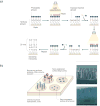Nanomedicine--challenge and perspectives
- PMID: 19142939
- PMCID: PMC4175737
- DOI: 10.1002/anie.200802585
Nanomedicine--challenge and perspectives
Abstract
The application of nanotechnology concepts to medicine joins two large cross-disciplinary fields with an unprecedented societal and economical potential arising from the natural combination of specific achievements in the respective fields. The common basis evolves from the molecular-scale properties relevant to the two fields. Local probes and molecular imaging techniques allow surface and interface properties to be characterized on a nanometer scale at predefined locations, while chemical approaches offer the opportunity to elaborate and address surfaces, for example, for targeted drug delivery, enhanced biocompatibility, and neuroprosthetic purposes. However, concerns arise in this cross-disciplinary area about toxicological aspects and ethical implications. This Review gives an overview of selected recent developments and applications of nanomedicine.
Figures

















References
-
- Feynman RP. In: Nanotechnology: Research and Perspectives. Lewis J, editor. MIT Press; Boston: 1992. p. 347.
-
- Gleiter H. Prog Mat Sci. 1989;33:223.
-
- Binnig G, Rohrer H, Gerber C, Weibel E. Phys Rev Lett. 1982;49:57.
-
- National Nanotechnology Initiative. Leading to the Next Industrial Revolution A Report by the Interagency Working Group on Nanoscience, Engineering and Technology. Washington, DC: Committee on Technology, National Science and Technology Council; 2000.
Publication types
MeSH terms
Substances
Grants and funding
LinkOut - more resources
Full Text Sources
Other Literature Sources

